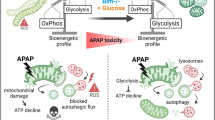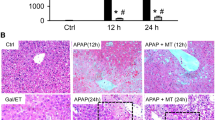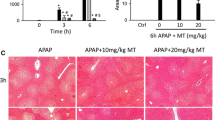Abstract
Atractyloside (Atr) binds to the adenine nucleotide translocator (ANT) and inhibits ANT-mediated ATP/ADP exchange on the inner mitochondrial membrane. In addition, Atr can trigger opening of a non-specific ion channel, within the ANT-containing permeability transition pore complex (PTPC), which is subject to redox regulation and inhibited by cyclosporin A (CsA). Here we show that the cytotoxic effects of Atr, both in vivo and in vitro, are determined by its capacity to induce PTPC opening and consequent mitochondrial membrane permeabilization (MMP). Thus, the Atr-induced MMP and death of cultured liver cells are both inhibited by CsA as well as by glutathione (GSH) and enhanced by GSH depletion. Similarly, the hepatorenal toxicity of Atr, assessed in vivo, was reduced by treating mice with CsA or a diet rich in sulfur amino acids, a regime which enhances mitochondrial GSH levels. Atr injection induced MMP in hepatocytes and proximal renal tubular cells, and MMP was reduced by either CsA or GSH. Acetaminophen (paracetamol)-induced acute poisoning was also attenuated by CsA and GSH, both in vitro and in vivo. Altogether these data indicate that PTPC-mediated MMP may determine the hepatorenal toxicity of xenobiotics in vivo.
Similar content being viewed by others
References
Dehrmann FM, Bye SN, Dutton MF The isolation of a storage organelle of atractyloside in Callipeis laureola. J Ethnopharmacol 1991; 34: 247–251.
Hatch RC, Jain AV, Weiss R, Clark JD Toxicologic study of carcoxyatractyloside (active principle in cocklebur-Xanthium strumarium) in rats treated with enzyme inducers and inhibitors and glutathione precursor and depletor. Am J Vet Res 1982; 43: 111–116.
Stewart MJ, Steenkamp V The biochemistry and toxicity of atractyloside: A review. Ther Drug Monit 2000; 22: 641–649.
Obatomi DK, Blackburn RO, Bach PH Effects of the calcium channel blocker verapamil and sulphydryl reducing agent dithiothreitol on atractyloside toxicity in precision-cut rat rental cortical and liver slices. Food Chem Toxicol 2001; 39: 1013–1021.
Roux P, Le Saux A, Fiore C, Schwimmer C, Dianoux AC, Trezeguet V, Vignais PV, Lauquin GJ, Brandolin G Fluorometric titration of the mitochondrial ADP/ATP carrier protein in muscle homogenate with atractyloside derivatives. Anal Biochem 1996; 234: 31–37.
Majima E, Shinohara Y, Yamaguchi N, Hong YM, Terada H Importance of loops of mitochondrial ADP/ATP carrier for its transport activity deduced from reactivities of its cysteine residues with the sulfhydril reagent eosin-5-maleimide. Biochemistry 1994; 33: 9530–9536.
Halestrap AP, Woodfield KY, Connern CP Oxidative stress, thiol reagents, and membrane potential modulate the mitochondrial permeability transition by affecting nucleotide binding to the adenine nucleotide translocase. J Biol Chem 1997; 272: 3346–3354.
Costantini P, Belzacq A-S, Vieira HLA, Larochette N, de Pablo M, Zamzami N, Susin SA, Brenner C, Kroemer G Oxidation of a critical thiol residue of the adenine nucleotide translocator enforces Bcl-2-independent permeability transition pore opening and apoptosis. Oncogene 2000; 19: 307–314.
Vieira HL, Haouzi D, El Hamel C, Belzacq AS, Brenner C, Kroemer G Mitochondrial membrane permeabilization during apoptosis. Impact of the adenine nucleotide translocator. Cell Death Differ 2000; 7: 1146–1154.
Klingenberg M The ADP-ATP translocation in mitochondria, a membrane potential controlled transport. J Membrane Biol 1980; 56: 97–105.
Marzo I, Brenner C, Zamzami N, Susin SA, Beutner G, Brdiczka D, Rémy R, Xie Z-H, Reed JC, Kroemer G The permeability transition pore complex: A target for apoptosis regulation by caspases and Bcl-2 related proteins. J Exp Med 1998; 187: 1261–1271.
Beutner G, Rück A, Riede B, Welte W, Brdiczka D Complexes between kinases, mitochondrial porin, and adenylate translocator in rat brain resemble the permeability transition pore. FEBS Lett 1996; 396: 189–195.
Marzo I, Brenner C, Zamzami N, J ürgensmeier J, Susin SA, Vieira HLA, Prévost M-C, Xie Z, Matsuyama S, Reed JC, Kroemer G Bax and adenine nucleotide translocator cooperate in the mitochondrial control of apoptosis. Science 1998; 281: 2027–2031.
Crompton M, Virji S, Ward JM Cyclophilin-D binds strongly to complexes of the voltage-dependent anion channel and the adenine nucleotide translocase to form the permeability transition pore. Eur J Biochem 1998; 258: 729–735.
Woodfield K, Ruck A, Brdiczka D, Halestrap AP Direct demonstration of a specific interaction between cyclophilin-D and the adenine nucleotide translocase confirms their role in the mitochondrial permeability transition. Biochem J 1998; 336: 287–290.
Bauer MKA, Schubert A, Rocks O, Grimm S Adenine nucleotide translocase-1, a component of the permeability transition pore, can dominantly induce apoptosis. J Cell Biol 1999; 147: 1493–1501.
Crompton M Mitochondrial intermembrane junctional complexes and their role in cell death. J Physiol 2000; 15: 11–21.
Kroemer G, Reed JC Mitochondrial control of cell death. Nat Med 2000; 6: 513–519.
Brustovetsky N, Klingenberg M Mitochondrial ADP/ATP carrier can be reversibly converted into a large channel by Ca2+. Biochemistry 1996; 35: 8483–8488.
Rück A, Dolder M, Wallimann T, Brdiczka D Reconstituted adenine nucleotide translocator forms a channel for small molecules comparable to the mitochondrial permeability transition pore. FEBS Lett 1998; 426: 97–101.
Brenner C, Cadiou H, Vieira HLA, Zamzami N, Marzo I, Xie Z, Leber B, Andrews D, Duclohier H, Reed JC, Kroemer G Bcl-2 and Bax regulate the channel activity of the mitochondrial adenine nucleotide translocator. Oncogene 2000; 19: 329–336.
Kroemer G, Dallaporta B, Resche-Rigon M The mitochondrial death/life regulator in apoptosis and necrosis. Annu Rev Physiol 1998; 60: 619–642.
Zamzami N, El Hamel C, Muñoz C, Brenner C, Belzacq A-S, Costantini P, Molle G, Kroemer G Bid acts on the permeability transition pore complex to induce apoptosis. Oncogene 2000; 19: 6342–6350.
Jacotot E, Ferri KF, El Hamel C, Brenner C, Druillenec S, Hoebeke J, Rustin P, Métivier D, Lenoir C, Geuskens M, Vieira HLA, Loeffler M, Belzacq A-S, Briand J-P, Zamzami N, Edelman L, Xie ZH, Reed JC, Roques BP, Kroemer G Control of mitochondrial membrane permeabilization by adenine nucleotide translocator interacting with HIV-1 Vpr and Bcl-2. J Exp Med 2001; 193: 509–520.
Vieira HL, Belzacq A-S, Haouzi D, Bernassola F, Cohen I, Jacotot E, Ferri KF, Hamel EH, Bartle LM, Melino G, Brenner C, Goldmacher V, Kroemer G The adenine nucleotide translocator: A target of nitric oxide, peroxynitrite and 4-hydroxynonenal. Oncogene 2001; 20: 4305–4316.
Belzacq AS, El Hamel C, Vieira HLA, Cohen I, Haouzi D, Metivier D, Marchetti P, Goldmacher V, Brenner C, Kroemer G The adenine nucleotide translocator mediates the mitochondrial membrane permeabilization induced by lonidamine, arsenite and CD437. Oncogene 2001; 20: 7579–7587.
Fiore C, Tezeguet V, LeSaux A, Roux P, Schwimmer C, Dianoux AC, Noel F, Lauquin GJM, Brandolin G, Vignais PV The mitochondrial ADP/ATP carrier: Structural, physiological and pathological aspects. Biochimie 1998; 80: 137–150.
Zoratti M, Szabò I The mitochondrial permeability transition. Biochem Biophys Acta-Rev Biomembranes 1995; 1241: 139–176.
Bernardi P The permeability transition pore. Control points of a cyclosporin A-sensitive mitochondrial channel involved in cell death. Biochim Biophy Acta (Bioenergetics) 1996; 1275: 5–9.
Petit PX, Goubern M, Diolez P, Susin SA, Zamzami N, Kroemer G Disruption of the outer mitochondrial membrane as a result of mitochondrial swelling. The impact of irreversible permeability transition. FEBS Lett 1998; 426: 111–116.
Quin ZH, Wang Y, Kikly KK, Sapp E, Kegel KB, Aronin N, DiFiglia M Pro-caspase-8 is pre-dominantly localized in mitochondria and released into cytoplasm upon apoptotic stimulation. J Biol Chem 2001; 276: 8079–8086.
Susin SA, Lorenzo HK, Zamzami N, Marzo I, Larochette N, Alzari PM, Kroemer G Mitochondrial release of caspases-2 and-9 during the apoptotic process. J Exp Med 1999; 189: 381–394.
Susin SA, Lorenzo HK, Zamzami N, Marzo I, Snow BE, Brothers GM, Mangion J, Jacotot E, Costantini P, Loeffler M, Larochette N, Goodlett DR, Aebersold R, Siderovski DP, Penninger JM, Kroemer G Molecular characterization of mitochondrial apoptosis-inducing factor. Nature 1999; 397: 441–446.
Zamzami N, Susin SA, Marchetti P, Hirsch T, Gómez-Monterrey I, Castedo M, Kroemer G Mitochondrial control of nuclear apoptosis. J Exp Med 1996; 183: 1533–1544.
Susin SA, Zamzami N, Castedo M, Hirsch T, Marchetti P, Macho A, Daugas E, Geuskens M, Kroemer G Bcl-2 inhibits the mitochondrial release of an apoptogenic protease. J Exp Med 1996; 184: 1331–1342.
Haouzi D, Lekethal M, Tinel M, Vadrot N, Caussanel L, Letteron P, Moreau A, Feldmann G, Fau D, Pessayre D Prolonged, but not acute, glutathione depletion promotes Fasmediated mitochondrial permeability transition and apoptosis in vivo. Hepatology 2001; 33: 1181–1188.
Bump EA, Taylor YC, Brown JM Role of glutathione in the hypoxic cell cytotoxicity of misonidasole. Cancer Res 1983; 43: 997–1002.
Feldmann G, Haouzi D, Moreai A, Durand-Schneider AM, Bringuier A, Berson A, Mansouri A, Fau D, Pessayre D Opening of the mitochondrial permeability transition pore causes matrix expansion and outer membrane rupture in Fas-mediated hepatic apoptosis in mice. Hepatology 2000; 31: 674–683.
Daugas E, Susin SA, Zamzami N, Ferri K, Irinopoulos T, Larochette N, Prevost MC, Leber B, Andrews D, Penninger J, Kroemer G Mitochondrio-nuclear redistribution of AIF in apoptosis and necrosis. FASEB J 2000; 14: 729–739.
Ferri KF, Jacotot E, Blanco J, Esté JA, Zamzami A, Susin SA, Brothers G, Reed JC, Penninger JM, Kroemer G Apoptosis control in syncytia induced by the HIV-1-envelope glycoprotein complex. Role of mitochondria and caspases. J Exp Med 2000; 192: 1081–1092.
Khaspekov L, Friberg H, Halestrap A, Viktorov I, Wieloch T Cyclosporin A and its nonimmunosuppressive analogue NMe-Val-4-cyclosporin A mitigate glucose/oxygen deprivationinduced damage to rat cultured hippocampal neurons. Eur J Neurosci 1999; 11: 3194–3198.
Martinou I, Desagher S, Eskes R, Antonsson B, Andre E, Fakan S, Martinou JC The release of cytochrome c from mitochondria during apoptosis of NGF-deprived sympathetic neurons is a reversible event. J Cell Biol 1999; 144: 883–889.
von Ahsen O, Renken C, Prkins G, Kluck RM, Bossy-Wetzel E, Newmeyer DD Preservation of mitochondrial structure and function after Bid-or Bax-mediated cytochrome c release. J Cell Biol 2000; 150: 1027–1036.
Prescott LF Paracetamol: Past, present, and future. Am J Ther 2000; 7: 143–147.
Rocha GM, Michea LF, Peters EM, Kirby M, Xu Y, Ferguson DR, Burg MB. Direct toxicity of nonsteroidal antiinflammatory drugs for renal medullary cells, 2001.
Chan K, Han XD, Kan YW An important function of Nrf2 in combating oxidative stress: Detoxification of acetaminophen. Proc Natl Acad Sci USA 2001; 98: 4611–4616.
Vancompernolle K, Van Herrewghe F, Pynaert G, Van de Craen M, De Vos K, Totty N, Sterling A, Fiers W, Vandenabeele P, Grooten J Atractyloside-induced release of cathepsin B, a protease with caspase-processing activity. FEBS Lett 1998; 6: 150–158.
Yamaguchi N, Kagari T, Kasai M Inhibition of the ryanodine receptor channels in the sarcoplasmic reticulum of skeletal muscle by an ADP/ATP translocase inhibitor, atractyloside. Biochem Biophys Res Commun 1999; 258: 247–251.
Marchetti P, Castedo M, Susin SA, Zamzami N, Hirsch T, Haeffner A, Hirsch F, Geuskens M, Kroemer G Mitochondrial permeability transition is a central coordinating event of apoptosis. J Exp Med 1996; 184: 1155–1160.
Narita M, Shimizu S, Ito T, Chittenden T, Lutz RJ, Matsuda H, Tsujimoto Y Bax interacts with the permeability transition pore to induce permeability transition and cytochrome c release in isolated mitochondria. Proc Natl Acad Sci USA, 1998; 95: 14681–14686.
Vande Velde C, Cizeau J, Dubik D, Alimonti J, Brown T, Israels S, Hakem R, Greenberg AH BIP3 and genetic control of necrosis-like cell death through the mitochondrial permeability transition pore. Mol Cell Biol 2000; 20: 5454–5468.
Hortelano S, Dallaporta B, Zamzami N, Hirsch T, Susin SA, Marzo I, Bosca L, Kroemer G Nitric oxide induces apoptosis via triggering mitochondrial permeability transition. FEBS Lett 1997; 410: 373–377.
Hehner SP, Hofmann TG, Ratter F, Dumont A, Dröge W, Schmitz ML Tumor necrosis factor-alpha induced cell killing and activation of transcription factor NF-kappa B are uncoupled in L929 cells. J Biol Chem 1998; 273: 18117–18121.
Doi T, Motoyama N, Tokunaga A, Watanabe T Death signals from theBcell antigen receptor target mitochondria, activating necrotic and apoptotic death cascades in a murine B cell line, WEHI-231. Int Immunol 1999; 11: 933–941.
Budd SL, Tenneti L, Lishnak T, Lipton SA Mitochondrial and extramitochondrial apoptotic signaling pathways in cerebrocortical neurons. Proc Natl Acad Sci USA 2000; 97: 6161–6166.
O'Neill AJ, O'Neill S, Hegarty NJ, Coffey RN, Gibbons N, Brady H, Fitzpatrick JM, Watson RW Glutathione depletioninduced neutrophil apoptosis is caspase 3 dependent. Shock 2000; 14: 605–609.
Yerushahlmi B, Dahl R, Devereaux MW, Gumpricht E, Sokol RJ Bile acid-induced rat hepatocyte apoptosis is inhibited by antioxidants and blockers of the mitochondrial permeability transition. Hepatology 2001; 33: 616–626.
Tafani M, Minchenko DA, Serroni A, Farber JL Induction of the mitochondrial permeability transition mediates the killing of HeLa cells by staurosporine. Cancer Res 2001; 61: 2459–2466.
Gurevich RM, Regula KM, Kirshenbaum LA Serpin protein CrmA suppresses hypoxia-mediated apoptosis of ventricular myocytes. Circulation 2001; 103: 1984–1991.
Author information
Authors and Affiliations
Rights and permissions
About this article
Cite this article
Haouzi, D., Cohen, I., Vieira, H.L.A. et al. Mitochondrial permeability transition as a novel principle of hepatorenal toxicity in vivo . Apoptosis 7, 395–405 (2002). https://doi.org/10.1023/A:1020026923038
Issue Date:
DOI: https://doi.org/10.1023/A:1020026923038




